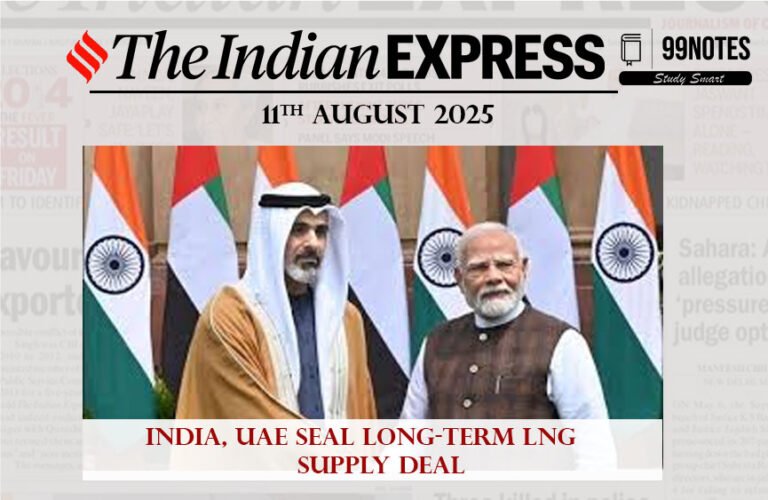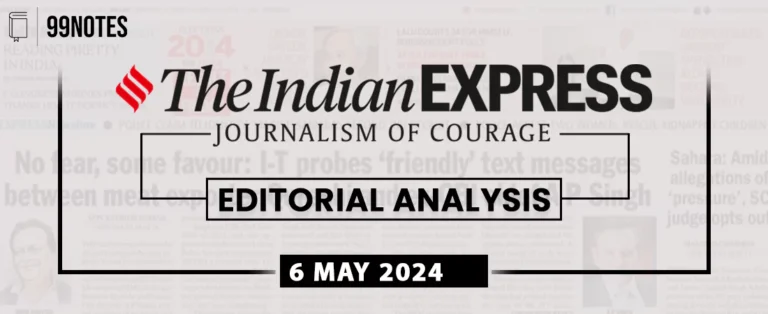2 Feb 2024 : Indian Express Editorial Analysis
Indian Express Editorial Analysis
2-February-2024
1. Stability over political gestures
| Topic: GS3 – Indian Economy – Issues relating to Planning This topic is relevant for Mains in the context of detailed analysis and discussions related to economic theory, fiscal policies, government expenditure, deficit management, and other complex economic concepts. |
| Context: |
|
More about the news:
Introduction:
- The economic theory suggests that governments should adjust their spending based on the confidence levels of private firms and households.
- During periods of low confidence where private entities hold back spending, governments are encouraged to increase spending.
- Conversely, once confidence is restored, the government should reduce expenditure.
- This counter-cyclical fiscal strategy aims to smoothen economic growth and make it more sustainable.
Fiscal Discipline in Government Actions:
- Contrary to expectations, the government has demonstrated a commitment to macroeconomic stability over political considerations.
- The fiscal deficit target for FY2024-25 is set at 5.1% of GDP, lower than economist projections.
- The Finance Minister reaffirms a goal to bring the deficit below 4.5% of GDP by FY2025-26.
- If achieved, this would signify a significant unwinding of the fiscal expansion prompted by the pandemic.
Impact of Interest Costs and Debt-to-GDP Ratio:
- The fiscal scars of the pandemic, reflected in higher interest expenses due to a nearly 10% jump in the debt-to-GDP ratio, highlight the necessity of fiscal discipline for several years.
- Bringing the debt-to-GDP ratio back to pre-COVID levels is crucial for maintaining the government’s ability to support growth during unexpected shocks.
Quality of Spending and Economic Vulnerabilities:
- The text emphasizes the importance of improving the quality of spending to address an elevated debt-to-GDP ratio.
- While spending on infrastructure contributes to GDP both during construction and in subsequent years, consumption-focused spending typically has a one-time impact.
- The government appears to be cautiously calibrating its tightening measures as confidence in economic recovery grows.
Medium-Term Drivers of Growth:
- The focus on medium-term drivers of growth is evident in the government’s allocation of resources.
- Capital expenditure, particularly for interest-free loans to private firms for research, is expected to grow faster than overall spending.
- This aligns with a broader strategy to enhance the economy’s growth potential in the medium term.
Budget Assumptions and Fiscal Consolidation:
- Credible assumptions underlie fiscal consolidation efforts, with nominal GDP growth at 10.5% and an increase in tax-to-GDP ratios consistent with prior trends.
- The government’s move towards transparency by reducing extra-budgetary spending is noted.
- The primary deficit in FY25 could already be close to pre-COVID levels, indicating progress in fiscal management.
Concerns Regarding Deficit Financing
- Despite an unchanged fiscal deficit in absolute terms in a growing economy, concerns arise about deficit financing.
- The reliance on market borrowings and inflows to small-savings schemes is highlighted.
- Higher government cash balances, potentially reaching levels significantly above normal, could lead to unintended consequences, intensifying liquidity stresses in the banking system.
Conclusion:
- By adhering to the promised fiscal consolidation path, the government exhibits a welcome trend towards medium-term fiscal management.
- This not only provides predictability to the private sector and financial markets but also attracts global bond investors seeking exposure to India.
- The potential response of rating agencies to these actions remains an area of interest.
| Economic Planning in India |
|
| PYQ: How are the principles followed by the NITI Aayog different from those followed by the erstwhile Planning Commission in India? (250 words/15m) (UPSC CSE (M) GS-3 2018) |
| Practice Question: Analyze the role of counter-cyclical fiscal strategies in promoting economic stability, citing examples from recent government policies. (150 words/10 m) |
2. NEGLECTING THE FARM
| Topic: GS3 – Agriculture – Issues related to Direct & indirect farm subsidies This topic is relevant for Mains in the context in-depth analysis and discussions related to agriculture, budgetary allocations, fiscal policies, and potential areas for improvement. |
| Context: |
|
More about the news:
Allocation Trends in Agriculture and Farmers Welfare Department:
- The article notes a marginal 0.6% uptick in the allocation for the Department of Agriculture and Farmers Welfare (MoAFW), which, in real terms, amounts to a decrease.
- The Department of Agricultural Research and Education (DARE) experiences a slight increase, while the Ministry of Fisheries, Animal Husbandry, and Dairying witnesses a commendable 27% rise, particularly addressing concerns such as foot-and-mouth disease and methane emissions.
Budgetary Support in the Agriculture-Food Sector:
- The focus shifts to budgetary support in the agriculture-food sector, primarily revolving around welfare measures and subsidies.
- Noteworthy components include food and fertilizer subsidies, the Mahatma Gandhi National Rural Employment Guarantee Act (MGNREGA), PM-KISAN, credit subsidies, and the PM-Fasal Bhima Yojana.
- The combined support for these measures amounts to Rs 5.52 trillion for FY25, contributing significantly to the interim budget.
Food Subsidy and Consumer Bias:
- The article highlights a consumer-oriented bias in budget allocations, specifically in food subsidies, which see a 3.3% drop.
- The article questions the necessity of extending the PM-Garib Kalyan Yojana’s support to 800 million people, emphasizing the need for rationalizing the food subsidy.
- It suggests emulating the rationalization strategy employed by former PM Atal Bihari Vajpayee in the Targeted Public Distribution System (TPDS).
Rationalization of Food Subsidy and Potential Savings:
- The article advocates for the rationalization of food subsidies along the lines of the TPDS, potentially saving the government around Rs 50,000 crore.
- The savings could be redirected towards agricultural research and development, including micro-irrigation, fostering more efficient resource utilization and ensuring food security in the face of climate change.
Fertilizer Subsidy and Need for Rationalization:
- The article discusses a reduction in fertilizer subsidies from Rs 1.89 trillion (RE, FY24) to Rs 1.64 trillion (BE, FY25).
- It emphasizes the need for rationalization, proposing a shift from subsidizing urea prices to empowering farmers through direct cash transfers.
- The potential savings, estimated at Rs 30,000-40,000 crore, could be redirected to enhance development initiatives like PM-KISAN.
Conclusion:
- The article concludes by acknowledging the muted budget for agriculture, expressing hope for major announcements in the July budget to make agriculture vibrant and sustainable.
- It recognizes the constraints of an election year, suggesting that substantial changes might be deferred to the later budget.
| PYQ: What are the major challenges of Public Distribution System (PDS) in India? How can it be made effective and transparent? (UPSC CSE (M) GS-3 2022) (150 words/10 m) |
| Practice Question: Critically examine the consumer-oriented bias in food subsidies and the need for rationalization, drawing parallels with the Targeted Public Distribution System (TPDS). Evaluate the impact of such rationalization on the economy and propose alternative measures for effective resource allocation in the agriculture sector. (250 words/15 m) |
For Enquiry

13 February 2024 : The Hindu Editorial Notes PD

13 Feb 2024 : Indian Express Editorial Analysis

13 February 2024 : PIB Summary for UPSC

12 Feb 2024 : Daily Current Affairs Quiz

12 Feb 2024 : Daily Answer Writing

12 Feb 2024 : Daily Current Affairs

12 Feb 2024 : Indian Express Editorial Analysis

12 February 2024 : The Hindu Editorial Notes PDF

12 February 2024 : PIB Summary for UPSC

10 Feb 2024 : Daily Current Affairs Quiz
Feb 2024 The Hindu 13 February 2024 : The Hindu Editorial Notes PD The Hindu Editorial
13-February-2024
1. A global alliance to bridge the gender equity gap
Topic:…
Indian Express 13 Feb 2024 : Indian Express Editorial Analysis Indian Express Editorial Analysis
13-February-2024
1. A science for us
Topic: GS2 – Governance…
feb 2024 PIB 13 February 2024 : PIB Summary for UPSC PIB Summary for UPSC
13-February -2024
1. Union Minister G Kishan Reddy inaugurate regional centre…
Daily Quiz 12 Feb 2024 : Daily Current Affairs Quiz 12 Feb 2024 : Daily Quiz…
mains answer writing 12 Feb 2024 : Daily Answer Writing Mains Answer Writing
12-February-2024
Q1) “Water scarcity threatens economic and social gains…
Daily Current Affairs 12 Feb 2024 : Daily Current Affairs Daily Current Affairs
12-February-2024- Top News of the Day
1. Great Indian Bustards give Nandyal a…
Indian Express 12 Feb 2024 : Indian Express Editorial Analysis Indian Express Editorial Analysis
12-February-2024
1. CLASSROOM VS COACHING
Topic: GS2 – Social…
Feb 2024 The Hindu 12 February 2024 : The Hindu Editorial Notes PDF The Hindu Editorial
12-February-2024
1. A privileged strategic partnership, without a gulf
Topic:…
feb 2024 PIB 12 February 2024 : PIB Summary for UPSC PIB Summary for UPSC
12-February -2024
1. Birth anniversary of Swami Dayanand Saraswati
Topic:…
Daily Quiz 10 Feb 2024 : Daily Current Affairs Quiz 10 Feb 2024 : Daily Quiz…




